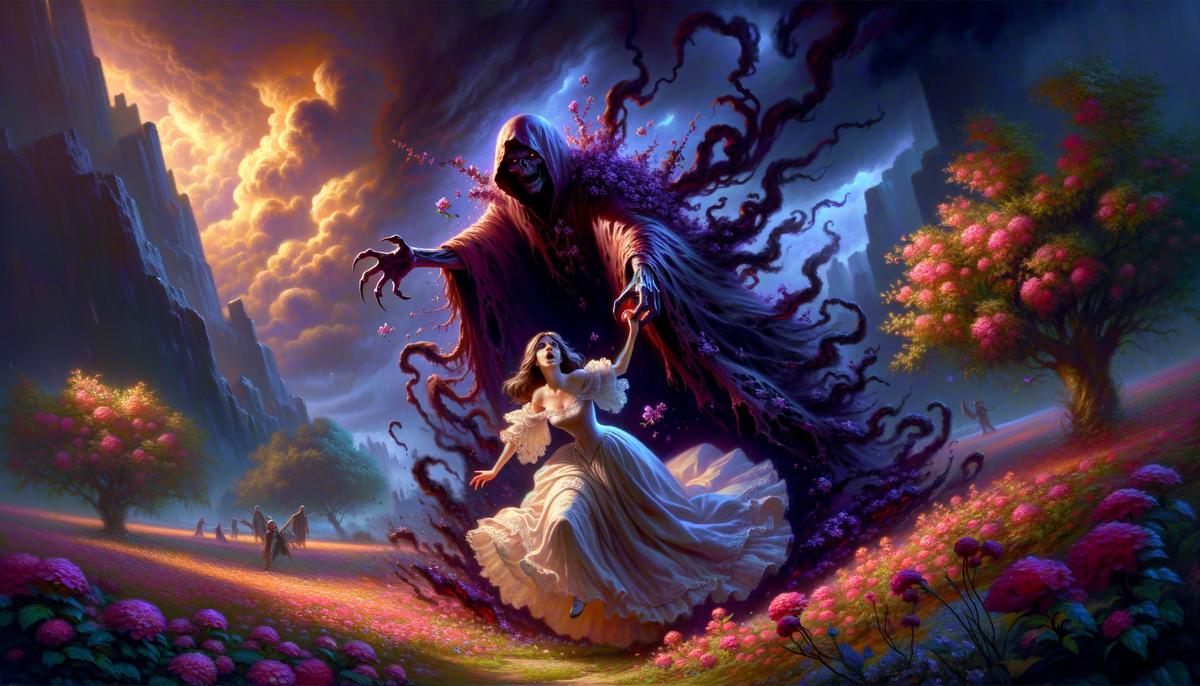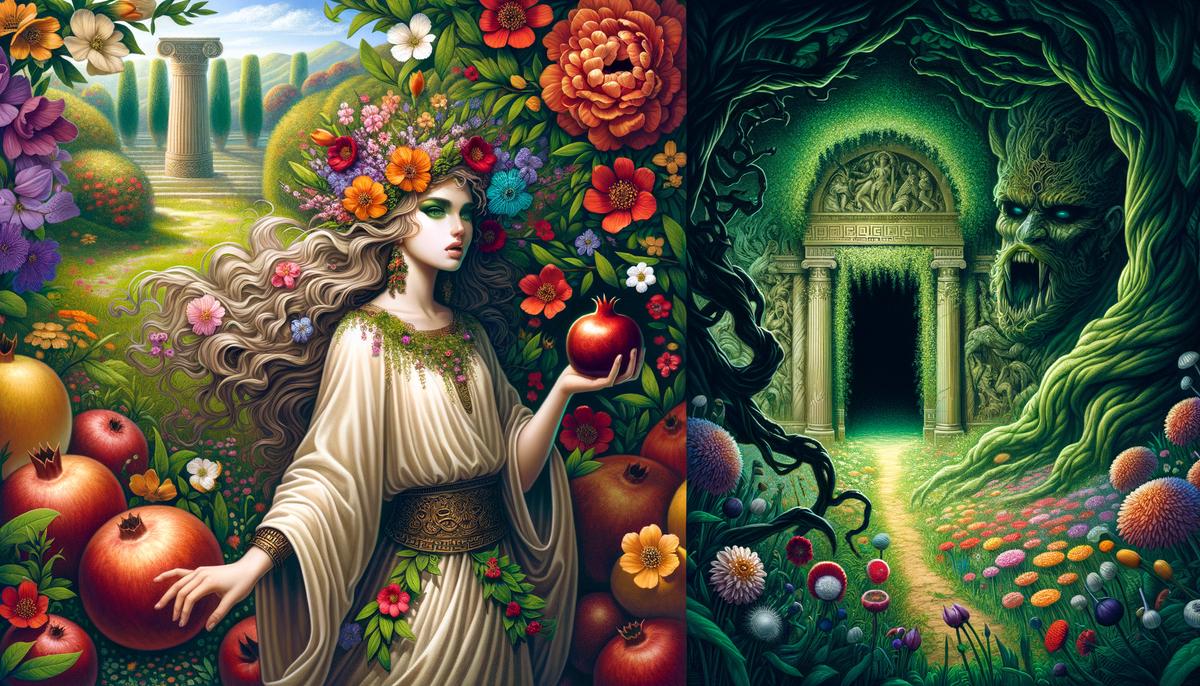Persephone's Dual Roles
Persephone's existence straddles two incredibly different worlds – each offering a distinct perspective on her essential roles within Greek mythology. As the cherished daughter of Demeter, goddess of the harvest, Persephone embodies the freshness and vitality of spring. Her presence alone commands the reawakening of the earth, causing flowers to bloom and grain to grow.
Yet, there's another compelling facet to her being. Kidnapped by Hades and compelled to become his wife, Persephone holds a somber dominion as the Queen of the Underworld. This dual rulership over both life and death places her at the heart of ancient agricultural myths.
When winter scatters its last frosts and gives way to spring, Greek storytellers venerated this change as Persephone's joyous return from the dreary Underworld. Her arrival was said to rekindle Demeter's joy, resulting in the vibrant resurgence of life on Earth. They perceived this resurrection of the natural world as a mirroring of agricultural cycles:
- Planting
- Growing
- Harvesting
Conversely, when Persephone departs from the sunlit realm to join Hades again, it symbolizes the retreat into the darker, barer months. Ancient lore portrays these periods as Demeter mourning her separation from Persephone by halting the growth on earth—a poetic allegory for the barrenness of winter.
It's intriguing how seamlessly this narrative encapsulates themes like death and rebirth—core aspects not only of agriculture but also of human existence. Persephone's story reverberates a symbolic simplicity: life flourishes when she is enthroned by lush greenery; and when she retreats to the shadowy depths, life pauses, waiting for her perennial return.
This profound cyclic role of Persephone reflects a haunting duality—she is both life-giving and associated with death, meshed perfectly into the rhythm of seasons and reflecting the realities of life and the inevitability of death, handed down through generations in myth weaving an enchanting tapestry of the ancient understandings of the natural world. As the young goddess bridges these two drastically different realms, she forms a nuanced figure resonating deeply with human themes of renewal and transition, embroiled in an eternal dance that impacts the mortals caught between her two conflicting identities.

The Abduction and Marriage to Hades
The narrative of Persephone's marriage begins with a divisive act—the infamous abduction orchestrated by Hades. This storyline puts the tender blossoms against the somber shades of the Underworld and laces myth with motifs of trickery and forbidden fruits.
The tales recounted this abduction with ambiguous motives. In most versions, whether motivated by unyielding love or by a desperate loneliness that plagues even gods, Hades was struck with infatuation upon seeing Persephone. With Zeus's somewhat complicit approval, Hades burst through a chasm in the earth, kidnapping Persephone while she innocently collected flowers. This dramatic scene paints Hades as an overzealous lover and shrouds the act in deceit laden with shades of premeditation—forever tethering Persephone to the world below.
Enter, then, the pomegranate, a symbol so loaded that it leaves scholars drooling for interpretation. The pomegranate seeds presented to Persephone by Hades aren't just a snack—they're the kernels of fate. By consuming them, Persephone sealed her tie to the Underworld. Some versions suggest Hades tricked her into eating them, offering Persephone the seeds while intentionally ensuring she could never fully return to her mother's sunlit pastures. In this act, Hades secures his queen but imposes a duality on Persephone that she might not have willingly chosen.
Let us ponder the implications of this, where a minor act of eating sets the eternal course of one's existence. This act often mirrors the traditional portrayals of ancient marriages, where consent was often overshadowed by familial arrangements and strategic alliances. Persephone's narrative casts a spotlight on the harsh realities for women in ancient Greek society—they had limited agency over their relationships and life-altering decisions connected to their personal lives.
The aspect of female desire—or in Persephone's case, the potential absence—matters a lot. But speaking of ancient cultures through modern lenses isn't always a tidy fit. However, by revisiting these narratives, we can uncover deeper layers in supposedly straightforward myths. It presents Persephone not just as a pawn or a passive participant but underscores her evolution within those constraints from a young maiden to a ruling figure of authoritative might and maternal resilience.
Through this lens, we realize the story isn't merely chronicling an abduction but a complex transformation and a subtle quest for autonomy within defined constraints. These myths encode early explorations of freedom—it's about stretching one's predicament leveraging all loopholes (including pomegranate seeds!) to modulate between victimhood and sovereignty.
Rediscovering these tales allows us to peek at the embroidery of antiquated thought patterns and to recognize the enduring vibrancy of Persephone as she governs realms, not just as Hades' queen, but as a potent symbol of rebirth and inevitable dualities of existence and even, resistance in quietude. As we delve deeper into these myths, we unravel not just stories but also their hidden entirety.

Persephone in Art and Culture
Persephone's enigmatic charm isn't just confined to the pages of dusty scrolls—it boldly resurfaces in countless forms of artwork stretching across centuries. The floral maiden and grim queen have had her contrasting personas painted, sculpted, and sung into a diverse array of cultural expressions.
Peek into any respected art museum, and you might encounter her imagined likenesses—from classic marble sculptures chiseled by anonymous ancient hands to the dramatic brush strokes by Renaissance painters captivated by her mythic transition. Each representation of Persephone not only invokes the renewal of Spring and the shades of the Underworld but also amplifies her nuanced roles through powerful visual narratives.
In ancient Greek art, Persephone frequently appears attired in robes fit for deities, often captured at the cusp of her abduction by Hades. These depictions sometimes show a rather passive Persephone, engulfed in the controlling narrative of Hades—but look closer. Ancient artists ingeniously used flowers in her headdress or garlands to signify her undeniable link with regeneration and life—an artistic choice paralleling her situation, somewhat mesmerizing onlookers and soliciting pity and hope.
Renaissance art revived her legacy by infusing humanistic touches into her myth, providing spectators with divinity formed in a more approachable imagining. Masters of this era explored the metaphors underlying Persephone's tale, using contrasts of light and shadow to tell the duality of her existence—enforced captivity with delicate touches of her eternal sorrow mixed with potent powers she harnessed as the Queen of the Underworld.
Entering the realm of the modern, Persephone migrates from traditional modes to more abstract interpretations in contemporary paintings and sculptures. These explorations often reflect on broader themes of female independence, agency, and coercion, tethered to a character whose story resonates with modern doctrines of rights and liberation.
In film and popular literature, Persephone's appearances often sway between villain and victim, but one constant remains: her central role fostering life and judging the dead—a narrative breathing both despair and hope into an eternal cycle that has survived through transitions in culture.
How does this flurry of artistic representations inform Persephone's role in mythology? Each iteration peels back a layer of her role as both victim and powerholder, providing a rich tapestry of emotional depth. It sheds light on human impulses of making sense out of nature's unfathomable rhythms—her portrayal as a life-bearing deity tackling melancholic but transformative captivities aligns with these musings.
By studying Persephone's footprint across canvases, stone, and digital avatars, we glean not only artistic variations but a transformation through historical thoughts and sensibilities—ideas calcifying around sufferance sprinkled with resilience. Interpreting her artistic journey through ages becomes a treasure hunt: every depiction is tantamount to realizing part of her story that might have been mused upon in radically different socio-cultural setups and yet feels remarkably relevant.
This dance of art forms that Persephone leads twirls us back into the heart of Greek myth, parading before our modern corridors as timeless testimony on how myths can perennially entwine thought threads through epochs, delivering nuanced splendor that remains forever fresh—like Spring itself reborn annually from Underworld's shadows under her gentle yet firm dominion. Thus, she endures: part terror, part beauty—all goddess.

Persephone's Influence in Religious Practices
From the verdant splendor of flowering meadows to the shadowed hush of the underworld, Persephone wielded more than just a scepter; she had a profound role at the core of ancient Greek religious practices. Look no further than the hallowed Eleusinian Mysteries to see how fundamental she was in the grain-sturdy heart of ritual and dogma. Persephone's seasonal shuffle from Earth to Underworld didn't just fill galleries and pages of poetry—it sowed the very seeds of Greek agricultural and religious life.
Shrouded in secret, the Eleusinian Mysteries were ancient Greece's exclusive spiritual event, reserved for initiates who were ready to be schooled in the invisible. Here, Persephone wasn't just a character; she was at the epicenter of this divine drama. Each year, the initiates would engage in pilgrimage rituals, beginning in Athens and traveling to Eleusis, mirroring Persephone's own annual commute between her two polar worlds.
It was dramatic: initiates reenacted her abduction, empathized with Demeter's overwhelming grief, and finally, rejoiced in Persephone's brief reunions with her mother, symbolizing the return of fertility to earth. But here's the crux—it fundamentally tied participants to Persephone's dual roles as regenerator of life and Queen of the Underworld.
But wading into more mystical waters, let's touch on the underlying essence of Eleusinian rites. These Mysteries focused not just on grain and growth but delved into life's eternal conundrum. Persephone's nibble on that pomegranate seed didn't just tether her to Hades; it ensured her as the priestess over an incessant cycle between life and the afterlife, making death (a presumably grim prospect) a bit more palatable. Considering folks back then weren't exactly cherishing any dreams of a light beaming heavenly ascent post-mortem, Persephone's gig assured them death might just be another type of harvest


Leave a Reply